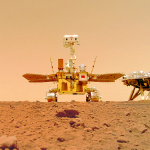NASA halts human moon lander work with SpaceX amid Blue Origin lawsuit0
- From Around the Web, Space
- August 21, 2021
NASA and SpaceX will stand down until Nov. 1.

NASA and SpaceX will stand down until Nov. 1.

The more Mars rovers, the merrier.

The quirk could cause unprecedented coastal flooding next decade.

Astronomers have captured some of the most detailed images ever seen of galaxies in deep space.

Six months ago, the craft started sending back never-before-seen views of the Red Planet

Astronomers think they have a new way to calculate the size of supermassive black holes: by studying the feeding patterns of these invisible giants.

Astronomers have discovered a splinter of stars and gas sticking out of the Milky Way Galaxy that is around 3,000 light-years long.

It’s a bizarre smear campaign.

Mark the date: 24 September 2182. That’s the day, according to a study released today, that a half-kilometer-wide asteroid called Bennu—recently visited by NASA’s OSIRIS-REx spacecraft—has the greatest chance of colliding with Earth in the next 300 years. The researchers behind the NASA-sponsored study emphasize that the risk of an impact remains very small—one in 2700, or 0.037%—and that, armed with the wealth of data from OSIRIS-REx’s 2 years orbiting the asteroid, they now know much more about it and the risk it poses.

The findings might challenge established models of the formation of gas giants.



